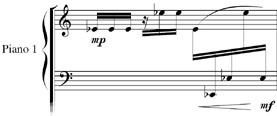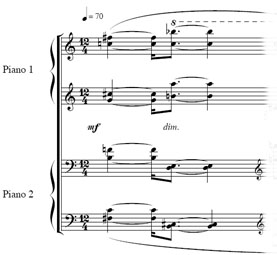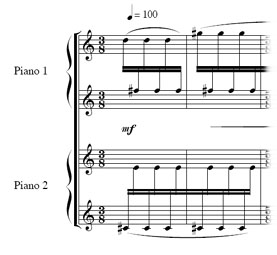For 2 pianos.
Here are five movements of a twelve movement cycle of realizations. The titles are taken from a student handbook called Studies for Composers devised in 1995 for post-graduate composers at the National Conservatoire of Greece.
From Studies for Composers (1995)
Consider these studies just as you would technical studies for an instrument. They are not to be worked through once and put away, but tried many times – from different angles; for different instrumentations. They are designed to be at the heart of a composer’s compositional thinking, as a reminder of the constant need to assess and reassess the role of those fundamental components that make up musical composition. They may also serve as the musician’s equivalent to a visual artist making quick sketches – short, sharp, to the point (even if you miss the point!). It is the ‘action and activity’ of composing that is important here, a kind of ‘composing practice’. The result of this approach should be a faster response and a keener imagination.
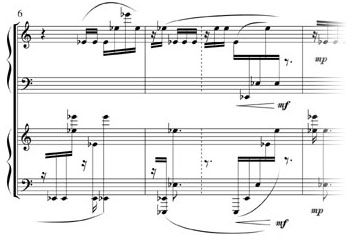
1. COMPOSITION WITH A SINGLE PITCH / Octaves allowed (project #1)
Test the memory within your imagination
Investigate – rhythm, density, activity, tempo, pace, dynamics
- Make clear phrase structures from passages containing single pitch music;
- Over time play one note – add another note. Is the basis of rhythm?
- Consider using first a solo instrument then a pair of similar instruments;
- Consider graphic representations.
Dispensing with the need to think beyond a single pitch or pitch class should speed up your ability to imagine a large-scale (or larger than usual) musical statement. But, how much can you recall? Practise imagining for n seconds and going into instant recall mode for (n x 2) seconds.
2. INTERVAL INVESTIGATION (projects #2-3)
Do intervals carry strong associations and ‘colours’?
Do intervals expressed as chords carry strong associations and ‘colours’?
Make a table of intervals you commonly use and describe how each interval might function within your music.
Min2
‘a blues slide’
Unstable with strong colour High register
Maj2
‘as a grace note’
Softer and more stable High register
Min3
‘as accompaniment’
Pulsating and rhythmic Medium register
And so on…
Create a study for two instruments that treat intervals like tuned sets of drums; there is no harmony, only what each interval brings to the moment. Alexander Goehr said in an interview when asked about composing with intervals:
intervals are such colourless things. Do you agree?
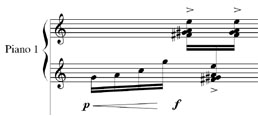
3. CHORDAL CHORALE (project
#4)
Imagine creating a sequence of chords. Imagine a steady (very) slow pulse or random distances between chords.
i. How are chords or pitch aggregates conceived?
ii. Can you describe what happens as one chord moves to the next?
iii. If so, can you demonstrate this using a music example rather than
words?
Create a chord or pitch aggregate: how will you ‘make’ the next chord or sonic consequence? Is this going to be Voice-Leading versus the Consequence of Sound Complexes?
Create a sequence of chords or pitch aggregates. Consider a graphic scheme that dispenses with identifying individual pitches and concentrates on pitch zones or regions.
iv. How crucial is the attack and/or sustain element? Consider what instrumentation you might think about here: for piano, for string quartet, for electronic sounds?
v. What minimum dimensions horizontally and vertically can produce an effective choral?
Attempt to express your conclusion.
4. EVOLVING CHANGE IN CHORDAL CHORALE
(project #5)
Part1
- Find, create, develop a single chord;
- Make the second chord you create different by only one pitch;
- How radical can you make this evolutionary process over a series of chords?
- Try to imagine the sound of the next chord before identifying a pitch to change.
Part2
- Find, create, develop a single chord;
- Make a second chord that retains one pitch as a pedal from the previous chord;
- How radical can you make this evolutionary process over a series of chords?
- Try to imagine the sound of the next chord before identifying a pitch to change.
Downloads
Study score [pdf]
- Octaves and Unisons – Reference Recording [mp3]
2. Interval Investigation 1/2 – Reference Recording [mp3]
3. Interval Investigation 2/2 – Reference Recording [mp3]
4. Chordal Choral – Reference Recording [mp3]
5. Evolving Change in Chordal Choral – Reference Recording [mp3]

